
How NOT to Hack Sales: 5 Strategies That Don’t Work (And 4 That Do)
If you Google the term “sales hacks,” you’ll literally find close to 70 million (yes, million!) results in just 0.60 seconds.

Yet as we’ve seen over the last 20 years, most of that advice just doesn’t work. Why? Because it’s often self-serving and numbers-driven… making it all about us and very little to do with our buyers.
Yes, the end goal is to generate more leads and close more deals. But if you’re only focusing on those two items, it’s no wonder you’re struggling.
So how do you get back on track and accelerate your sales growth for the long haul?
That’s exactly what I’m here to break down.
But before we dig in, it’s important to understand why some of the most popular sales hacks don’t work. Understand their flaws, and you’ll be less tempted to use them again while leaning into what works.
How NOT to Hack Sales: 5 Strategies That Don’t Work and Should Be Avoided
Use these sales hacks, and you’ll get more leads and convert those leads faster!
That’s the gimmick, not the truth. And it makes my stomach turn every single time.
And yet sales leaders and salespeople fall into this trap all the time. You’ve likely even seen these “hacks” fail yourself.
Most of them instantly turn off your buyers, causing you to lose out on sales now and in the future. So that puts you even further behind your goals. Talk about a lot of opportunities left on the cutting room floor!
Plus, these “hacks” are annoying, if you don’t like being approached this way, why on earth do you think your buyers would embrace these icky tactics?!
These are the sales “hacks” I’m talking about (and the ones you should avoid):
1. Playing the Numbers Game
You’ve heard that sales is a numbers game. It’s supposedly all about getting in front of as many prospects as possible to boost your chances of closing more deals.
But how is that really going for you?
You may be fooling yourself into thinking the more people you reach out to, the better you’ll do (which isn’t necessarily a bad thing if you know your ICP like the back of your hand) only to face countless “no’s” and constant rejection.
Despite that sting, the bigger problem is losing a potential sale and future customer.
So why doesn’t this approach work?
Because simply going after more leads isn’t going to cut it.
Throwing sh%t against the wall without intentionality, thoughtfulness, and relevance only to hope something will stick is a recipe for wasted time, missed opportunities, and huge disappointments.
You may experience some short-term successes here and there. But you’re unlikely to achieve sustainable success because this is a self-serving approach — like many “hacks” on this list.
That’s why you feel like you’re spinning your wheels and wondering why your hard work isn’t panning out.
Constantly going after new customers doesn’t give you the time to actually learn about them and their needs (which is key to growing your sales and business).
Yes, you do need to grow your business. But you can’t effectively do that if you’re treating each buyer like a faceless number to solely serve yourself.
Rather than hoping one random lead eventually pans out, we’ll show you how to make your sales process relevant to build relationships that deliver real results.
2. Pitching Immediately After Connecting on LinkedIn
LinkedIn is a powerful platform filled with priceless opportunities. It’s important to remember what you put into it will be exactly what you get back from it.
Here’s a common situation you’ve probably also experienced:
You connect with someone on LinkedIn, and they immediately respond back with a sales pitch that has NOTHING to do with you, your business, or anything you’d be interested in. It’s even worse if you can see their process is clearly automated, impersonal, and spammy.
Being on the receiving end of this and removing every single connection that does this, shows these types of transactional interactions just don’t work.
After all, does this make you want to hurry up and schedule a time to talk? I didn’t think so.
So don’t expect your prospects to be any different (or less smart about it).
No one wants to be bombarded like this.
And if you continue to do so, you can expect your messages to immediately be placed in the archived, a removed connection and a scarlet letter turning people off.
So if people aren’t fooled by this self-serving approach, why waste your time and jeopardize your chances of making a genuine connection?
You’ll learn how to fix this mistake later, but we still have some more ground to cover in the meantime.
Hint, it’s about talking with people NOT at them.
3. Using Automated Email Sequences (Incorrectly)
Email sequences can be a valuable asset to your sales funnel. But that’s only if they’re done correctly.
Bad news? The majority of the time, they fall way short.
This is what we refer to as automated email cadence hell.
You sign up for a webinar, and all of a sudden, you’re thrown into an automated email abyss. You’re constantly bombarded with emails that aren’t relevant.
And the senders have no clue (or even care) whether you ever showed up for the webinar you expressed interest in attending.

If you’re doing this to your prospects, it’s no wonder your hard work of finding and generating leads isn’t paying off.
No one wants a series of irrelevant, unhelpful emails cluttering up their already overflowing inbox.
So don’t waste your or your prospect’s time with a lazily executed email sequence… especially when they rarely show up to the webinar they signed up for!
Speaking of that, this next mistake goes hand-in-hand with this one:
4. Using Your Webinar Follow-Up Series to Pitch Your Offerings
Bait-and-switch webinar tactics are a HUGE turnoff.
And we’ve all been there. And we’ll all be there again.
You see a webinar that catches your attention, you sign up to attend, then you get that barrage of emails just mentioned.
Why?
Companies that sponsor webinars get your emails and like to spam the mess out of you.
But that’s not even the worst part!
Sometimes you also get dumped into a sales funnel with countdowns and “Last Chance to Save” emails galore — for something you don’t even want.
The experience scares you off from signing up for another webinar ever again.
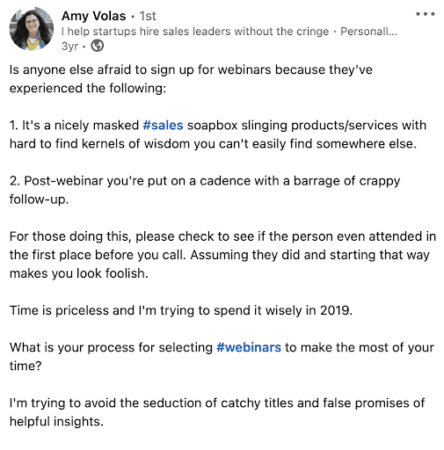
Your buyers are attending webinars to learn something or be part of a conversation that’s important to them, just like you.
They want to take that next step toward solving a problem, reaching a goal, understanding blind spots, getting better, or meeting other people like them.
But, again, just like you, that doesn’t mean they want to take a giant leap to buy just because you threw some useless information at them.
That’s why this is a terrible place to pitch what you have to offer. Think about how you can start a conversation that’s relevant to them with a valuable point of view that can help.
Again, I’ll show you a different approach below, but there’s one more sales hack you probably can’t afford to use either:
5. Offering Discounts
Discounts devalue your business.
Say it again with me: discounts devalue your business!
And with the pressure often comes the temptation to throw everything and the kitchen sink at our buyers trying to get them signed… especially when the pipeline is lackluster.
It’s why you’ll start to see more and more emails that offer last-ditch incentives to buy:
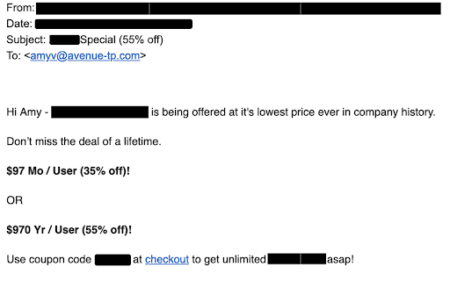
However, consider this a warning – tactics like these are a horrible idea.
While they might incentivize people to buy in the short term, they hamstring your business in the long run:
- You’re trading long-term profitability for short-term cash flow. McKinsey & Company found that a 1% discount reduced profitability by 8%.
- They attract people motivated solely by price and diminish the value you offer. You become a commodity, making it near impossible to compete on anything other than price.
- You train your customers to wait for a discount. Soon they won’t buy without it. Why pay full price when you know a promotion could pop up soon? Just wait until it’s time to renew or expand the business…
Not to mention, you’ll get lost in the shuffle of icky sales tactics, ending up as “just another company slinging product.” Is that really what you’re going for?
The good news is, there is a way to close the year strong without these tactics.
The data shows that closing techniques, pitches, etc. are not what close deals. Instead, it’s seeking to understand and meeting our buyers where they NOT trying to force them where we want them to be.
Yes, you may be able to capture that short-term win of a sale at a reduced price.
They’re also more likely to jump ship if someone else can do it for less.
Please STOP doing this.
This is just another self-serving sales hack that never works the way you want it to.
And it’s one you should avoid at all costs because, in the end, you’ll probably lose more money than you’ll ever earn on the deal.
So now that you know what NOT to do, let’s roll up our sleeves and dive into:
What to Do Instead and How to REALLY Hack Sales
Have you seen what I wrote about How to Hack Sales?
Essentially, to REALLY hack sales it comes down to understanding that without your buyers, you don’t have a business. And without a pipeline full of short, near, and long-term opportunities, you won’t have buyers.
Here’s how you do that well:
1. Stop Focusing on the Quantity of Leads and Give Quality Your Full Attention
We already talked about why the “sales is a numbers game” myth is such outdated advice.
A better, more effective approach is to work harder on your pipeline and focus on the quality of your leads, not quantity.
To move the needle in the right direction, consider:
- Where and how you capture your leads
- What you do to nurture them… hint, GIVE GIVE GIVE!
- How you stay in touch and foster relationships
- Embracing the long-game
Embracing these actions will help you improve your outcomes.
You’ll also need to consistently listen to your customer’s feedback. This allows you to fine-tune your approach to perfectly speak their language while understanding what’s important to them.
Once you do, you’ll quickly build trust and help people see that you’re the solution they’ve been looking for this whole time.
But that can’t happen if you treat each prospect like a number, quickly race through their pain points, and book them for the next sales step… just to get to the next lead.
That also ties right into this next sales hack:
2. Build Relationships on LinkedIn Instead of Only Seeing People as Potential Leads
At its core, LinkedIn is a place where people come to have conversations with other people to build professional relationships.
So stop being lazy while treating it like a place to pick up quick leads for your numbers game.
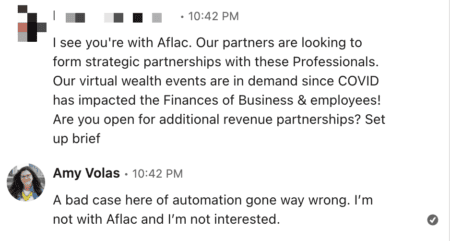
Instead, set your sights on initiating and fostering relationships with people.
Make an effort to connect over something meaningful, and you’ll find it much easier to get to know someone, their business, and their pain points.
The information you learn from showing up because you care will serve you well later when it’s time to talk about your products or services.
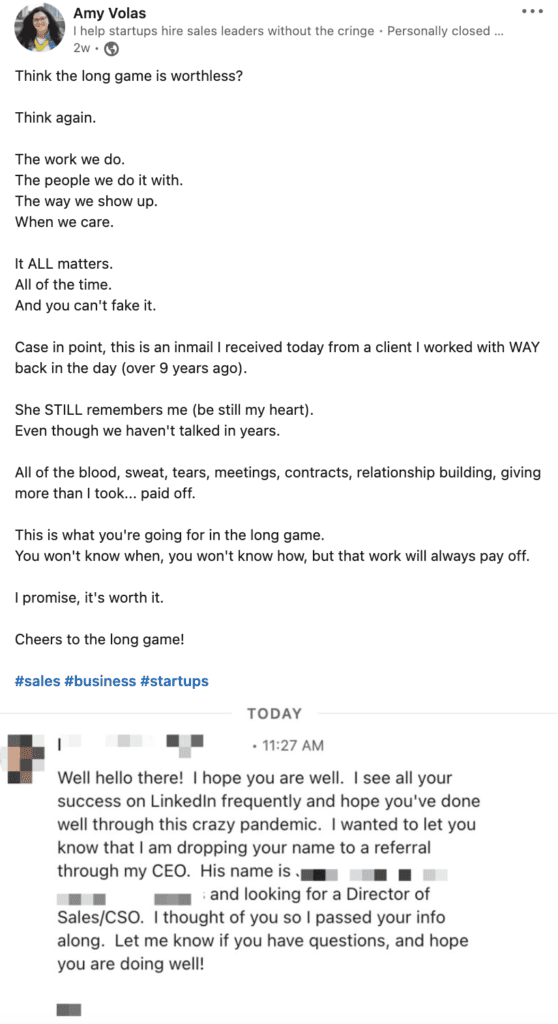
Ultimately, people want to be seen, heard, and understood. The people on LinkedIn are no different. Focus on relationships, being helpful, being part of the conversation, starting meaningful conversations, and watch the magic happen.
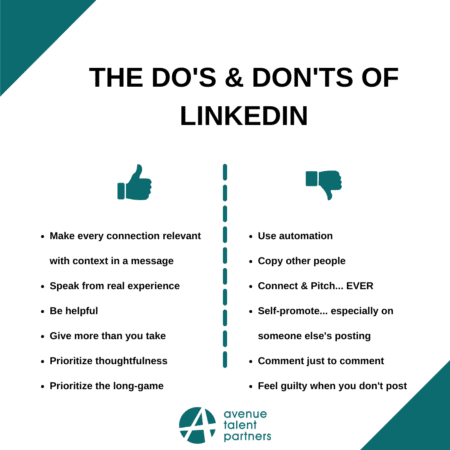
You’ll thank me later when you see a significant difference in the quality of your pipeline.
3. Don’t Pester People to Buy from You in an Email Sequence
The next sales hack to tackle is your email sequences.
We know you’ve heard that they can increase sales and slash the effort it takes to close deals under the guise of “efficiency.” But, again, how has this been working out for you? Have you taken a look at all of the opportunities left on the cutting room floor?
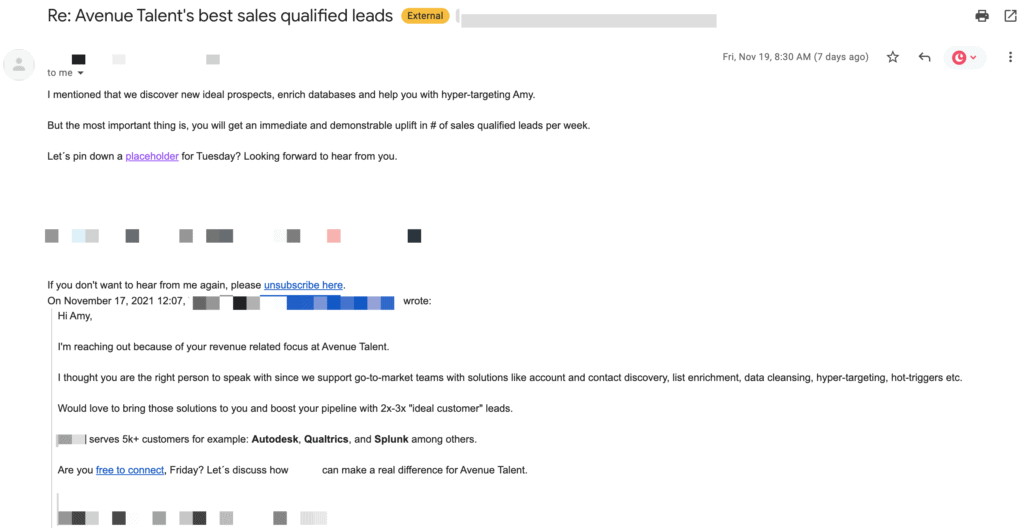
Of course a “guru” is going to tell you they work. They’re most likely selling the exact template or strategy they use.
Realistically, whatever efficiency you create on your end may cause you to lose potential customers and sales.
So if you want to see better results from your email campaigns (and who doesn’t?), you need to flip the script from sales emails talking at your buyers to conversation starters that lead with a helpful foot.
Stop pestering people to buy from your soulless email cadence — which just ends up being annoying.
Instead “show them you know them” like my friend Sam McKenna always says. Focus on what they’re doing, not trying to force something down their throat you think they should be doing. Empower them with intel to illustrate you care and are showing up to confirm/deny what might make sense… together.

Do this, and watch your response rates thank me for it.
Once recipients see you as a trusted source, they’ll have even more reason to check in and read your messages before they pile up and get buried in their inbox.
While you’re at it, you should do the same post-webinar, as you’ll see next.
4. Continue to Add Value After Your Webinar
When you follow up after your webinar, send a copy of the recording and a handy cheat sheet of talking points and actionable insight that will matter to them to go along with it.
Instead of immediately asking for the sale, make sure they actually showed up and if they did, ask them or offer things like:
- What they thought about XYZ point that was made
- How what was shared affects them
- If the information shared is useful to their business
- What was missing from the conversation that would make it more impactful
- What other events that have been standing out
- Offer to personally connect them with others that attended (that you know) that they’d like to get to know better
- Create a strategy session with a handful of key attendees that leaned into the points above with a particular topic that became a common theme
This is your chance to start a conversation to understand them on a deeper level long after the webinar ends.

You’ll learn so much about what’s important to them and the kernels of priceless knowledge you hadn’t even considered… which may spark an incredible topic for your next event or piece of content. Even better, they might have a question that feeds right into what your business does best.
The more you can help people and connect the dots for them, the less likely you’ll have to chase them down or have to pitch to them.
So go above and beyond with your webinar follow-ups to provide magnetic value to your audience.
Key Takeaway: Less You and More Them
The real sales hacks are those that focus on what matters… building relationships with people.
Anything else is just going to be self-serving and ineffective, and your buyers will see right through it. Leaving behind a dismal pipeline.
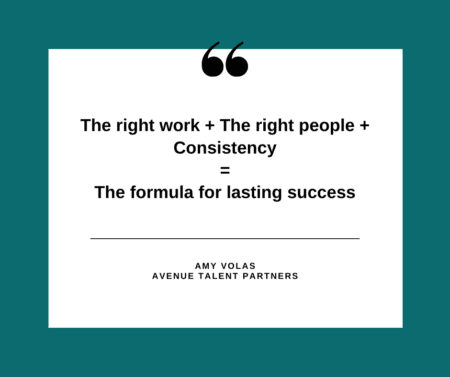
So rather than waste your time looking for shortcuts, do the work with the four “hacks” above and soon you’ll have a very completely different picture of your pipeline.
